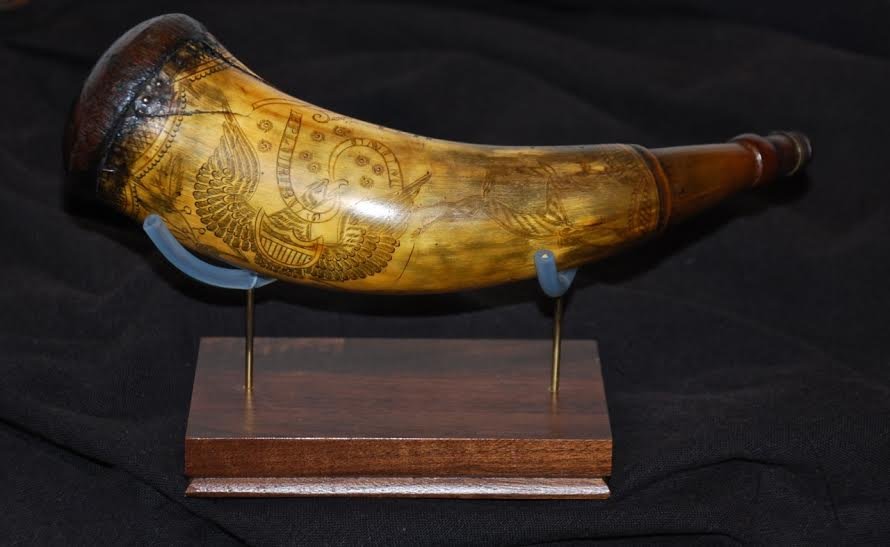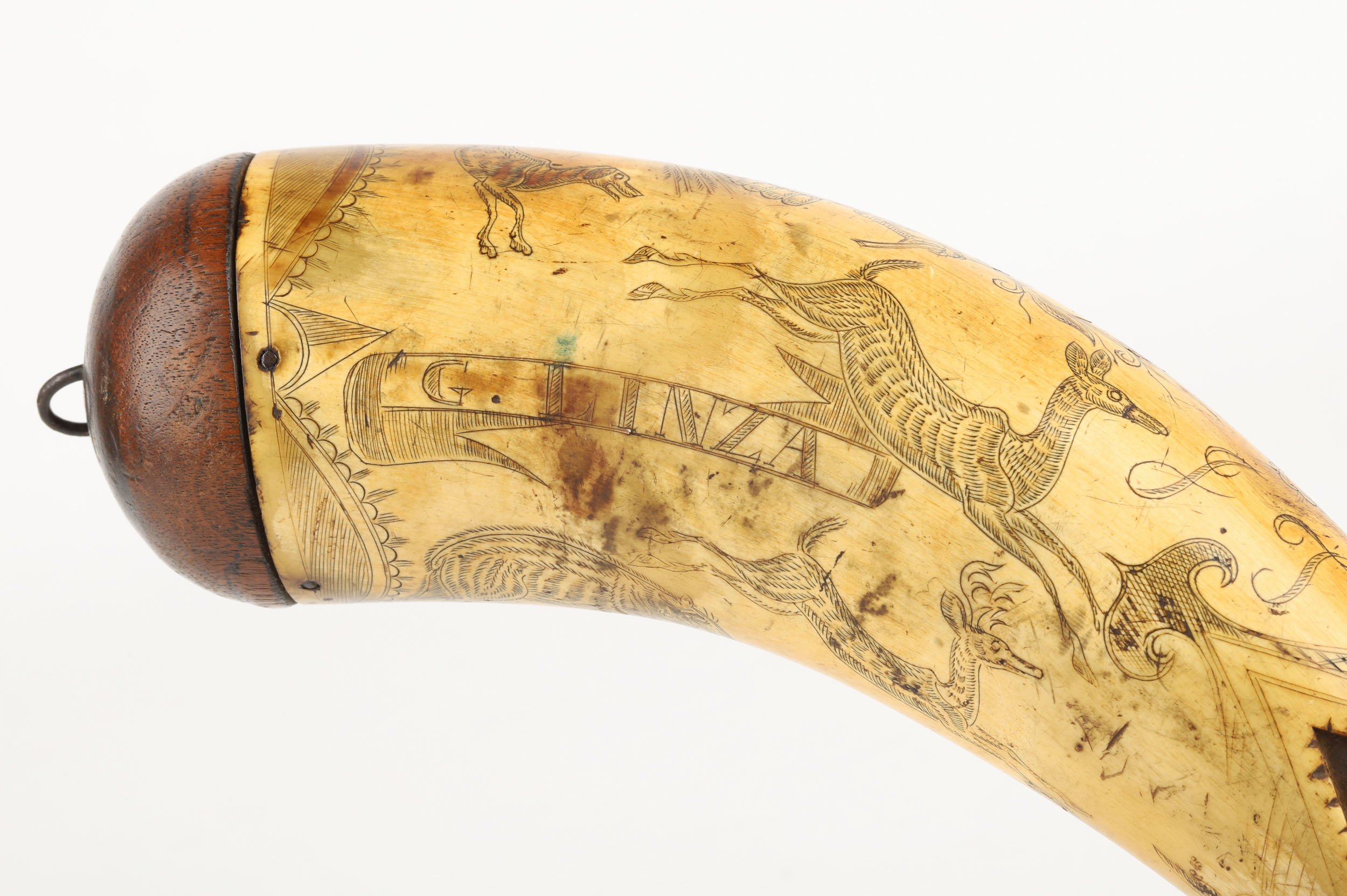Auctioning a hand-carved rarity by Francis Tansel
The patriarch of the Tansel family of powderhorn carvers
Freedom came at a high price in the 1790s, when Francis Tansel was weighing his options. France, where he was born around 1760, was in the grips of the French Revolution. King Louis XVI and his queen, Marie-Antoinette, were executed in 1793. Everywhere, ordinary men and women protested in the streets, chanting “Liberty, Equality and Fraternity,” and demanding fairness in government, taxation, employment opportunities and food costs.
Many supported the Declaration of the Rights of Man and of the Citizen, drafted in 1789 by the Marquis de Lafayette, with assistance from Thomas Jefferson, the primary author of the United States of America’s Declaration of Independence enshrined in 1776. While Lafayette’s document served as France’s basis for establishing a nation of free individuals protected equally by the law, the French Revolution would continue for a decade, concluding with the formation of the French Consulate in 1799.
Political upheaval and perpetual hunger are strong motivators for making a drastic life change. Perhaps both convinced Francis Tansel to start over in the United States. First settling in Virginia, he moved to Scott County, Kentucky around 1798, putting down roots as a farmer and family man, ultimately raising six sons and three daughters.
Liberty secured in his adopted country was clearly on Francis’ mind as he wielded his blades and adorned preserved cow horns. The hollowed out, lightweight cow horns carried gunpowder needed to fire muskets and long rifles used by soldiers, farmers and hunters in times of war and peace.
One prominent image Francis frequently replicated was the 1782 Great Seal of the United States, showing a bald eagle bearing a shield across its breast to represent supreme power and authority, and in its talons, an olive branch for peace and arrows for war. A banner declared the Latin motto: E pluribus unum, “out of many, one.”
Tansel’s signature American eagle with ‘E pluribus unum’ banner is depicted on the horn for sale at Miller & Miller Auctions.
Francis’ new American neighbours admired his folk art carvings and hired him to personalize their powder horns with meaningful images. Depending on the times, the etchings could reveal political commentary, war imagery or a freeze frame of daily Colonial life, depicting people, hunting dogs, horses, wildlife, flowers and other themes.
A short, sharp blade was used to cut a thin slit into the horn’s surface without removing material. Francis then wet his thumb to push gun powder dust, lampblack or other black carbon pigment into the cut to emphasize the carving. Waxing and normal handling of the powder horn sealed the surface and protected the carvings. Two centuries later, they are wonderfully clear.
“Francis’ earliest known powder horn was made about 1800 in Scott County and is known as ‘The Plain Truth’ horn from an inscribed banner; the horn is signed ‘F*T’ in a round cartouche. Francis’ first horns were not dated; his earliest dated horn is ‘1804,’ followed by an ‘1808’ horn and several ‘1809” horns,’ says Shelby W. Gallien of Ft. Wayne, Indiana. He has been collecting, researching, and publishing on Tansel powder horns for 40 years.
When called to bear arms and fight for America in the War of 1812, Francis also packed his carving tools. Stationed with Boswell’s Kentucky Detached Militia Regiment at Fort Meigs, Ohio in 1813, he carved several powder horns for militiamen wanting to commemorate their war experiences. As Francis expertly wielded the blade, he etched images of the fighting men and the fort, as evidenced by three horns that survive to this day.
After the war, carving became a Tansel family enterprise. Francis taught the folk art to his eldest son, John, born in 1800, who began carving at a young age. Sons Stark, born in 1807, and Timothy, born in 1810, also became respected horn carvers.
John’s earliest dated powder horn was made in April, 1819. Francis put down his own blade around 1821.
A powder horn carved by Francis Tansel’s first son, John. The similarities in carving style are striking. Source.
The Tansel family moved from Kentucky and re-established themselves in central Indiana in 1829, where they continued farming and carving. Combined, the Tansels produced several hundred pieces. Such impressive output may have been aided by Francis’ wife, daughters and other relatives, perhaps tasked with boiling and scraping the raw horns and making wooden plugs.
Gallien credits John as “the best carver” among the brothers, “while Timothy was the most prolific. Stark was a good carver, but signed so few of his horns that his work is difficult to attribute, leaving his abilities uncertain. Stark’s early horns were similar to John’s work, while his later horns were similar to Timothy’s. The latest known Indiana era horn is dated ‘1852’ and signed ‘Tim Tansel.’ By that time, the art form was no longer in vogue, and metal powder flasks and powder cans had become popular.”
A powder horn carved by Francis Tansel’s second son, Timothy. Source.
Original owners of Tansel creations had invested personal sentiment as well as cash. Their decedents who understood this treasured the powder horns as family heirlooms. The ornamental horns became desirable folk art. At recent auctions, powder horns by Timothy fetched $6,000 to $9,0000 US; by John, $15,000 to $20,000 US; and by Francis, $25,000 to $35,000 US.
Occasionally, a signed horn is sold to a discerning collector.
Roy Warwick of Ontario, Canada was just that lucky, no later than the 1940’s. Operating Warwick Lumber Yards, airports and other family concerns in Blenheim and the Kent County area could be demanding. Roy relaxed by hunting for choice artefacts, particularly antique firearms. Before he passed in 1983, Roy made certain his son, Bob, realized John Tansel’s carved powder horn is special.
“I have no idea how John Tansel’s powder horn came into my grandfather’s possession,” says Bob’s son, Dr. Bruce Warwick of Chatham. “Before Dad passed in 1996, he told me that it was a very valuable and rare piece.”
This particular powder horn by Francis Tansel will be offered as lot 261 in Miller & Miller’s May 14th sale.
Confirming the Warwicks’ powder horn was carved by John Tansel and inscribed ‘J T’ in large script letters, Gallien dates the piece to circa 1825, plus/minus a few years.
“Most carved figures on the horn are typical of mid-to-late 1820’s Tansel horns. The large Tansel-style federal eagle with shielded breast, arrows in one clawed foot and a leafy vine in the other, ‘E Pluribus Unum’ banner in its beak, and a field of stars overhead, is the primary decorative element when the horn is being carried. The large eagle is a ‘trademark’ of Tansel powder horns, along with the ‘fish mouth’ detail defining the spout,” Gallien points out.
A dog chasing deer depicted on the Warwicks’ horn is a standard image on most Tansel horns, according to Gallien. “In addition, a bear with short tail, big teeth and long claws is present; bears were also hunted with dogs in Kentucky when the horn was made. Large, scalloped borders are a traditional detail on Tansel horns of this vintage.”
“More interesting are the two bust-style figures of gentlemen with two names: ‘G. Linza’ and ‘Mc.Gufin’ in small cartouches, presumably those of the men” carved on the horn. Gallien finds most named horns have a single original owner’s name. He says, “Based on other Tansel horns with multiple names, the probable explanation for the two names is simple: the horn was gifted from one man to the other. Based on the quality differences in the cartouches framing the names, G. Linza was the owner of the horn with the more elaborate cartouche, and McGufin was the person who purchased the horn from John Tansel and gifted it to Linza.”
The name ‘G. Linza’ appears on the horn.
The name ‘Mc.Gufin’ also appears on the horn.
“A detail only seen on John’s work is the small ‘beard’ on the eagle’s ‘chin’ behind the lower beak. A second detail showing John’s hand is the cartouche around the name, ‘G. Linza,’ Gallien says. He also points out the “‘awkwardness’ in forming the curls on either end of the banner-shaped cartouche as it curls forward at the left end and backward at the right. Among the Tansels, John had the most difficulty forming realistic curls in banners.”
The carved images on the Warwicks’ powder horn are “clear, easily visible, with no significant damage. A small patch of ‘bag wear’ is present on the spout end’s scalloped border on the back side of the horn, but the wear spot does not interfere with any major carved images. Surface condition is very good, with the warm, yellowed patina preferred by most collectors. The walnut, lathe-turned butt plug has a good wear pattern and patina, complementing the horn,” says Gallien. He also observes “a period alteration to the original spout tip” was “nicely done” after it was “was damaged/cracked by its wood stopper being forced into the tip too firmly on too many occasions. The longer original tip (with decorative hand-carved beads and coves) was shortened to remove the damaged area, losing the original raised strap-retaining ring and most of the original decorative spout.”
Dr. Warwick feels privileged to be the third-generation owner of a genuine Tansel carved powder horn.
“Multiple generations and members of my family have all been firearm and artefact collectors, including me,” he says. The Warwicks owned Indian Head Arms, shipping and receiving hundreds of antique guns.
Bob Warwick was well-known in the firearms collector community. “Enfield and Winchester rifles were his specialty, although he collected everything related to firearms,” Dr. Warwick says. “When Dad died, I immediately sold 800 of his guns and kept back 100 of the best.”
That was in line with handling Grandfather Roy’s collections. “It took three days just to auction off the items our family didn’t want to keep!”
“I have a complete panel out of a Spitfire aircraft. It sits in my office, next to hundreds of other select artefacts,” Dr. Warwick confesses. “It is very hard for me to give up anything. But I’m 72 and I’m trying to be rational.”
Anticipating great American interest in the John Tansel powder horn, Dr. Warwick would rather it stay in Canada. “An American auction house has been calling me repeatedly to let them auction my horn. I realize I could get more by selling it in the States. However, I prefer Miller & Miller’s simple one-page contract. I had confidence in the father, Jim Miller, and now in his sons, Ethan and Justin.”
The John Tansel powder horn will be a highlight of the Canadiana & Decorative Arts sale hosted by Miller & Miller Auctions in New Hamburg, Ontario on Saturday, May 14, 2022.
“To me, the horn’s value is in its history, plus the fact it has been passed down in my family. The horn is something my father and grandfather both cherished – and so do I,” says Dr. Warwick.
“I hope it goes to a collector who really knows about powder horns and will appreciate it.”
By Karen Paton-Evans
Karen Paton-Evans has been sharing stories since age three and writing professionally for Canadian newspapers, magazines and private clients since 1985.
Auction Details:
Canadiana & Decorative Arts
May 14, 2022
Did you enjoy this story? Feel free to share it using the links below:




















